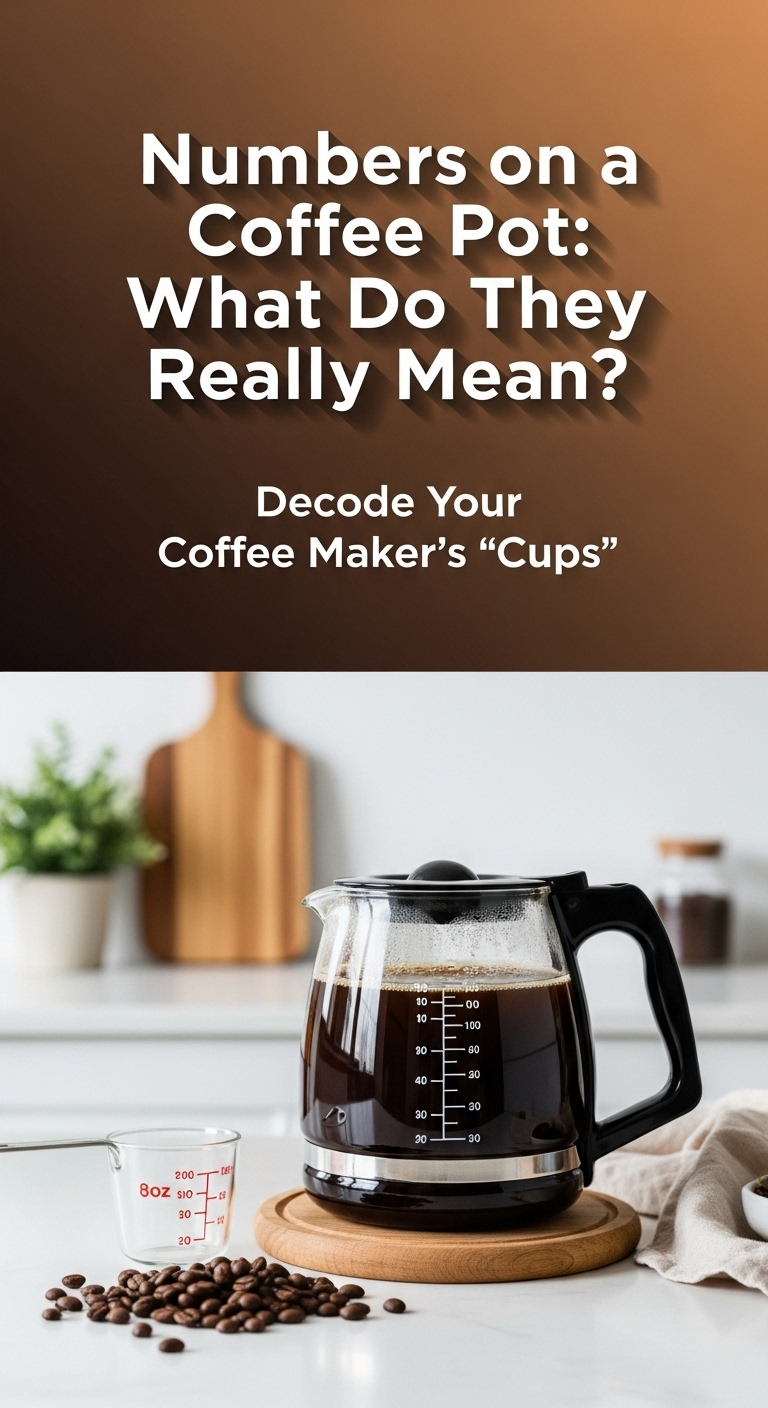As an Amazon Associate CoffeeXplore.com earns from qualifying purchases.
Numbers on a Coffee Pot: What Do They Really Mean?
Ever brewed a full ’12-cup’ pot of coffee only to find it fills just 7 or 8 of your favorite mugs? You’re not alone, and your coffee pot isn’t broken. This common kitchen mystery leads many to question if they’re measuring correctly or if the numbers on the carafe are simply wrong. The frustration of brewing what you think is a large amount of coffee, only to come up short, is a universal experience for drip coffee maker owners.
The discrepancy stems from a fundamental misunderstanding of what a “cup” means in the world of coffee manufacturing. A “cup” on a coffee pot does not equal a standard 8-ounce measuring cup. Instead, coffee manufacturers define their “cup” as a much smaller serving size, typically ranging from 4 to 6 fluid ounces. This single difference is the key to solving your brewing inconsistencies.
Leveraging extensive analysis of manufacturer standards and common user experiences, this guide will demystify the numbers on your coffee pot once and for all. We’ll break down why this measurement difference exists, show you how to calculate your pot’s true capacity, and provide you with a simple, three-step process to brew a perfectly consistent and delicious pot of coffee every single time. Get ready to take control of your coffee-to-water ratio and end the confusion for good.
Key Facts
- The “Coffee Cup” Standard: A “cup” marking on a coffee pot carafe is not the U.S. standard 8 fluid ounces. Evidence from numerous manufacturers shows it represents a smaller serving size, most commonly 5 or 6 fluid ounces.
- Actual vs. Advertised Volume: A 12-“cup” coffee maker does not hold 96 ounces (12 x 8 oz). It actually holds between 60 and 72 ounces, which yields about 7 to 9 standard-sized coffee mugs.
- Dual-Purpose Discrepancy: This smaller “cup” size serves two purposes. It technically accounts for the volume displaced by coffee grounds in the filter basket and also serves as a marketing tactic to make the machine’s capacity appear larger.
- The Golden Ratio for Brewing: For optimal flavor and strength, well-established brewing principles recommend the “golden ratio.” This is approximately 1 part coffee to 18 parts water by weight, which translates to about 10 grams of coffee for every 6 ounces of water.
- Standard Scoop Size: A typical coffee scoop is designed to hold 2 tablespoons of ground coffee. This amount is the generally recommended dose for one 6-ounce serving of brewed coffee.
Numbers on a Coffee Pot: The Real Meaning Behind the Lines
Have you ever meticulously filled your coffee pot with water to the “12” line, expecting a dozen servings, only to find it barely fills a handful of your go-to mugs? This isn’t a miscalculation on your part; it’s a deliberate design choice by coffee maker manufacturers. The core of the confusion lies in the definition of a “cup.”
A “cup” on a coffee pot does not equal a standard 8-ounce measuring cup. Instead, coffee manufacturers define their “cup” as a much smaller serving size, typically ranging from 4 to 6 fluid ounces.
This industry-standard “coffee cup” is based on a traditional serving size, similar to what you might find with a teacup. It is not a unit of measurement meant to align with the standard U.S. liquid measuring cup you use for baking or cooking. Once you understand this fundamental difference, the numbers on your carafe start to make sense as serving suggestions rather than precise volume markers.

The “Coffee Pot Cup” Explained: 5-6 Ounces is the Norm
So, if a coffee pot cup isn’t 8 ounces, what is it? While the exact measurement can vary slightly between brands, the vast majority fall within a very specific range. This smaller size is intended to represent a single, modest serving of coffee before adding milk or cream.
Quick Fact: This smaller ‘cup’ standard isn’t just for coffee; historically, tea and cocoa were also served in 6-ounce cups.
Here is what you can typically expect from the numbers on your coffee pot:
- The 6-Ounce Standard: Many coffee makers, especially older models, define their “cup” as 6 fluid ounces. This has long been the traditional size for a hot, mug-served beverage.
- The 5-Ounce Standard: A growing number of modern coffee makers, including many from the popular brand Mr. Coffee, use a 5-fluid-ounce “cup.” This makes the capacity seem even larger on the box.
- The 4-Ounce Outlier: While less common, some machines, particularly smaller, personal-sized models, may even use a 4-ounce cup measurement.
Because of this, most coffee makers, including popular brands like Mr. Coffee, define a “cup” as 5 or 6 ounces to represent a single serving, not a precise measurement. Always assume the number on your pot refers to one of these smaller volumes.
Why Your Coffee Pot “Lies” About Its Capacity
It can feel a bit deceptive when you realize your 12-cup machine can’t actually fill 12 of your cups. So is it a technical choice or a marketing trick? The truth is, it’s a little of both. There are two primary reasons why manufacturers use this smaller, non-standard measurement system.
- Technical Brewing Considerations: The first reason is practical. To brew balanced coffee, you need the right ratio of water to coffee grounds. When you add ground coffee to the filter basket, it absorbs water and takes up space. Manufacturers calibrate their “cup” lines to account for this water absorption and displacement. If they used a full 8 ounces of water for every “cup” of grounds, the resulting brew would often taste weak and under-extracted. The 5 or 6-ounce standard helps ensure a better coffee-to-water ratio for the average user.
- Marketing and Perceived Value: The second reason is purely about marketing. A “12-Cup Coffee Maker” sounds far more impressive and capable than a “60-Ounce Coffee Maker” or a “7-Mug Coffee Maker.” By using a smaller “cup” unit, manufacturers can advertise a higher number, making the appliance seem like it has a larger capacity and offers more value to the consumer. It’s a simple psychological trick that makes the product more appealing on a crowded store shelf.
In short, coffee makers use a smaller “cup” size for two main reasons: 1) to account for the volume of coffee grounds and prevent weak coffee, and 2) to advertise a larger number of “cups,” making the machine’s capacity seem bigger.
How Many Ounces Are in a 12-Cup Coffee Pot? (And Other Common Sizes)
Now for the practical application. Understanding the theory is one thing, but knowing how much coffee you’ll actually get is what really matters for your morning routine. A 12-cup coffee maker does not hold 96 ounces; it typically holds 60-72 ounces of coffee, which yields about 7 to 9 standard 8-ounce mugs.
Let’s do the math. Here’s what your coffee maker’s advertised capacity actually means in fluid ounces and the approximate number of standard 8 oz mugs you can expect to fill.
| Pot “Cup” Size | Based on 5 oz “Cup” | Based on 6 oz “Cup” | Approx. Standard 8 oz Mugs |
|---|---|---|---|
| 12-Cup Pot | 60 fl. oz. | 72 fl. oz. | 7 – 9 mugs |
| 10-Cup Pot | 50 fl. oz. | 60 fl. oz. | 6 – 7 mugs |
| 8-Cup Pot | 40 fl. oz. | 48 fl. oz. | 5 – 6 mugs |
| 4-Cup Pot | 20 fl. oz. | 24 fl. oz. | 2 – 3 mugs |
This table clearly illustrates the gap between the number on your pot and the number of mugs you can fill. A full 10-cup pot, for instance, will likely give you just over 6 full mugs of coffee, which is crucial information when you’re brewing for guests.
How to Brew Consistent Coffee: 3 Steps for Perfect Measurement
The key to overcoming the confusing markings on your carafe is to abandon them as a primary measurement tool. To get delicious, repeatable results, you need precision. The best way to achieve this is by using a consistent coffee-to-water ratio.
Pro Tip: For the most consistent results day after day, a simple kitchen scale is a coffee lover’s best friend. It removes all the guesswork.
The universally accepted standard for great coffee is the “golden ratio.” While it sounds complex, it’s quite simple: For perfect coffee, use the “golden ratio” of 1 part coffee to 18 parts water by weight. This is roughly 2 tablespoons (or 10 grams) of coffee grounds for every 6 ounces of water. By following these three steps, you can implement this ratio and take full control of your brewing process.
Step 1: Find Your Pot’s True “Cup” Size
Before you can ignore the lines, it’s helpful to know what your specific machine uses as its standard. This quick test will give you a definitive answer and confirm everything we’ve discussed.
To find your coffee pot’s “cup” size, fill the carafe with water to the “10-cup” line, then pour that water into a standard 8-ounce liquid measuring cup. If the water measures out to 50 ounces, you know your machine uses a 5-ounce “cup” (10 x 5 = 50). If it measures 60 ounces, it uses a 6-ounce “cup.” This simple experiment removes all doubt and gives you a baseline for your specific equipment.
Step 2: Measure Water by Ounces, Not “Cups”
This is the most critical behavioral change you can make for better coffee. Stop using the lines on the carafe to measure your water. Those lines are suggestions at best and are prone to misinterpretation.
Always use a separate, standard liquid measuring cup to measure the exact number of fluid ounces of water you need before pouring it into your coffee maker’s reservoir.
If you want to fill eight standard 8-ounce mugs, you need 64 ounces of water (8 x 8 = 64). Measure out exactly 64 ounces of fresh, cold water with a proper measuring cup and pour that into your machine. This ensures you start with the correct volume every single time, regardless of what the markings on the pot say.
Step 3: Measure Coffee by Weight (The Best Method)
Just as you should measure water precisely, the same applies to your coffee grounds. Measuring by volume (with scoops or tablespoons) is acceptable, but measuring by weight is far more accurate and repeatable. The density of coffee beans can vary by origin and roast level, meaning a scoop of a light roast might weigh less than a scoop of a dark, oily roast. A scale eliminates this variable completely.
Ready to level up your brew? Here are the numbers to start with:
- The Gold Standard (by Weight): For ultimate precision, use a kitchen scale. A great starting point is the “golden ratio”: approximately 10 grams of coffee for every 180mL (6 oz) of water.
- The Standard (by Volume): If you don’t have a scale, the general rule is two level tablespoons of ground coffee for every 6 ounces of water. A standard coffee scoop is designed to hold two tablespoons.
Start with these ratios and then adjust to your personal taste. If you prefer stronger coffee, use a little more grounds. For a milder cup, use slightly less. The key is that you are now making small, controlled adjustments from a precise and consistent baseline.
To achieve the ultimate precision in your brewing, a simple digital kitchen scale is the most valuable tool you can own. It removes all guesswork and ensures your coffee-to-water ratio is perfect every single time.
FAQs About Coffee Pot Measurements
Even after demystifying the “cup,” some specific questions often remain. Here are direct answers to the most common queries about coffee pot measurements.
Is a 12 cup coffee pot actually 12 cups?
No, a 12-cup coffee pot does not make 12 standard 8-ounce cups. It makes 12 smaller, 5-to-6-ounce “servings,” which equals about 60 to 72 ounces in total. This will typically yield about 7 to 9 standard-sized mugs of coffee.
Are coffee pot cups 6 or 8 oz?
Coffee pot “cups” are typically 5 or 6 ounces. They are almost never the standard 8 ounces that a U.S. measuring cup holds. The 8-ounce measurement is used for cooking and baking, not for the serving size markings on a coffee carafe.
Is a coffee scoop 1 or 2 tablespoons?
A standard coffee scoop holds approximately two tablespoons of coffee grounds. According to brewing best practices, one standard scoop (2 tbsp) is the recommended amount of coffee to use for one 6-ounce “cup” of water.
What do the numbers mean on a Mr. Coffee maker?
On a Mr. Coffee maker, the numbers indicate the quantity of 5-ounce servings. Therefore, the “12-cup” line on a Mr. Coffee carafe represents 60 ounces (12 servings x 5 oz per serving) of water, not 96 ounces.
How do I make my coffee stronger in a drip coffee maker?
To make your coffee stronger, you simply need to increase the amount of coffee grounds relative to the amount of water you use. Start with the standard ratio (e.g., 2 tablespoons of coffee per 6 oz of water) and add an extra half-scoop or full scoop to find the strength that best suits your taste.
Final Summary: Brew with Confidence, Not Confusion
The confusion surrounding the numbers on a coffee pot is a shared experience, but it’s one that’s easily solved with a bit of knowledge. By understanding that the “cup” on your carafe is a small, 5-to-6-ounce serving suggestion and not a standard unit of measurement, you reclaim control over your morning brew. The markings are not a lie, but rather a different language—one based on tradition and marketing, not culinary precision.
By abandoning the carafe lines in favor of a standard measuring cup for your water and a scale or consistent scoop for your coffee, you eliminate all the variables that lead to weak, strong, or inconsistent results. You can finally brew the exact amount of coffee you want, at the exact strength you love, day after day.
- The “Cup” Myth, Busted: Your coffee pot’s “cup” is 5 or 6 ounces, not 8.
- Measure with Precision: Always use a separate, standard measuring cup for water and a scale (or consistent scoop) for your coffee grounds.
- You Are in Control: Start with the golden ratio (2 tbsp of coffee per 6 oz of water) and adjust to create your perfect brew.
Take these insights and confidently brew your best coffee yet, starting tomorrow morning
Last update on 2025-12-05 / Affiliate links / Images from Amazon Product Advertising API

